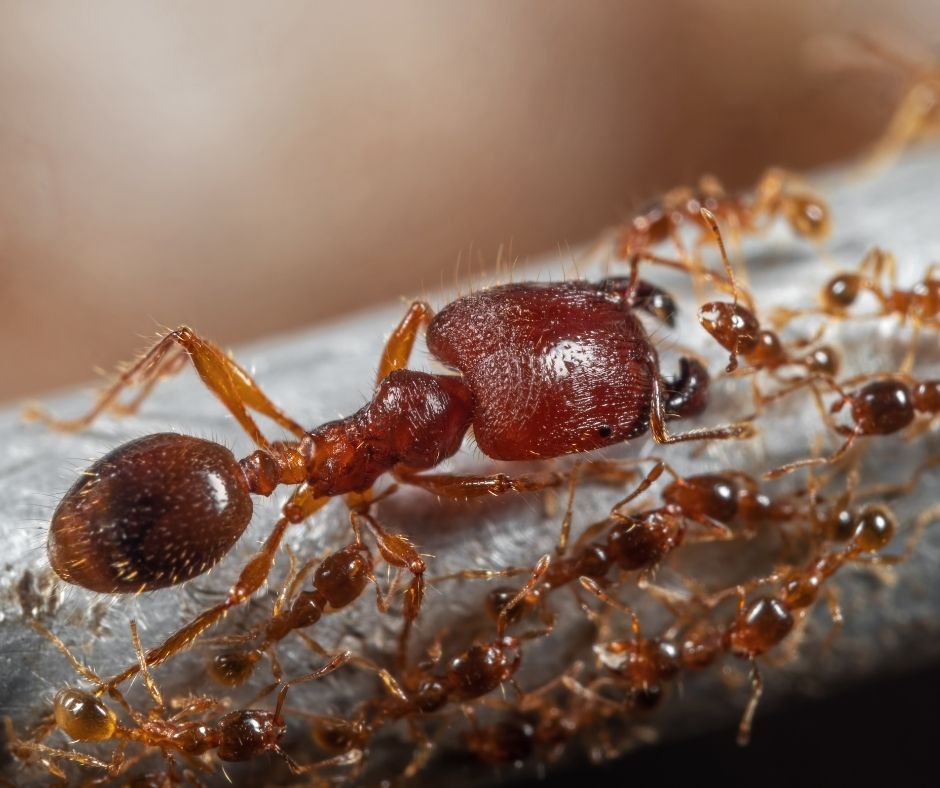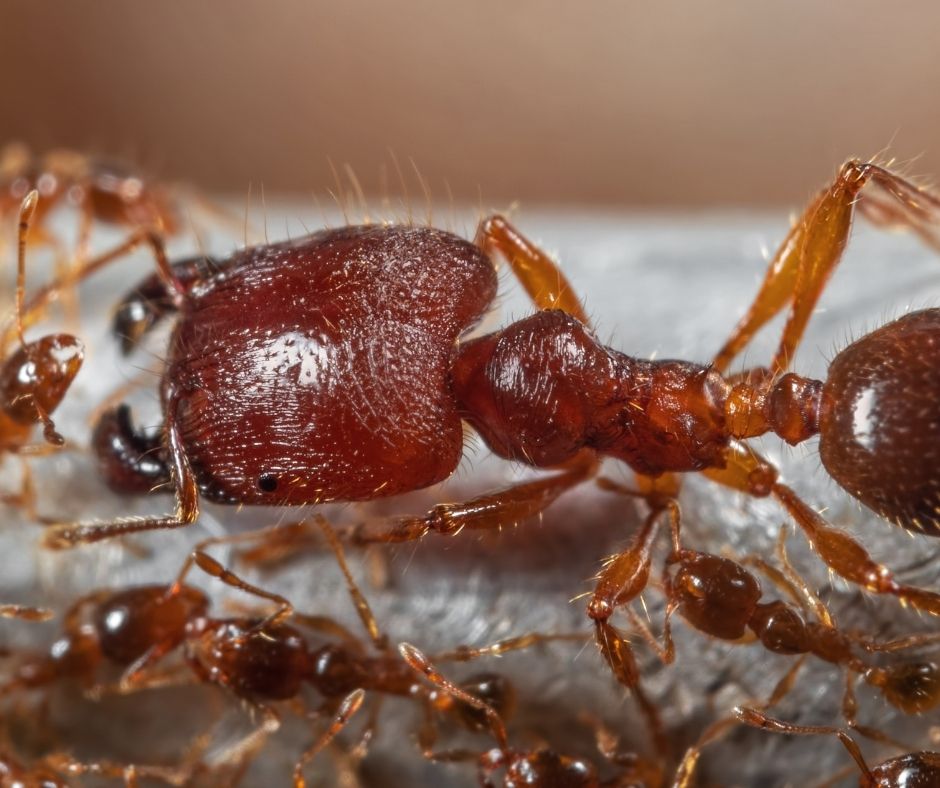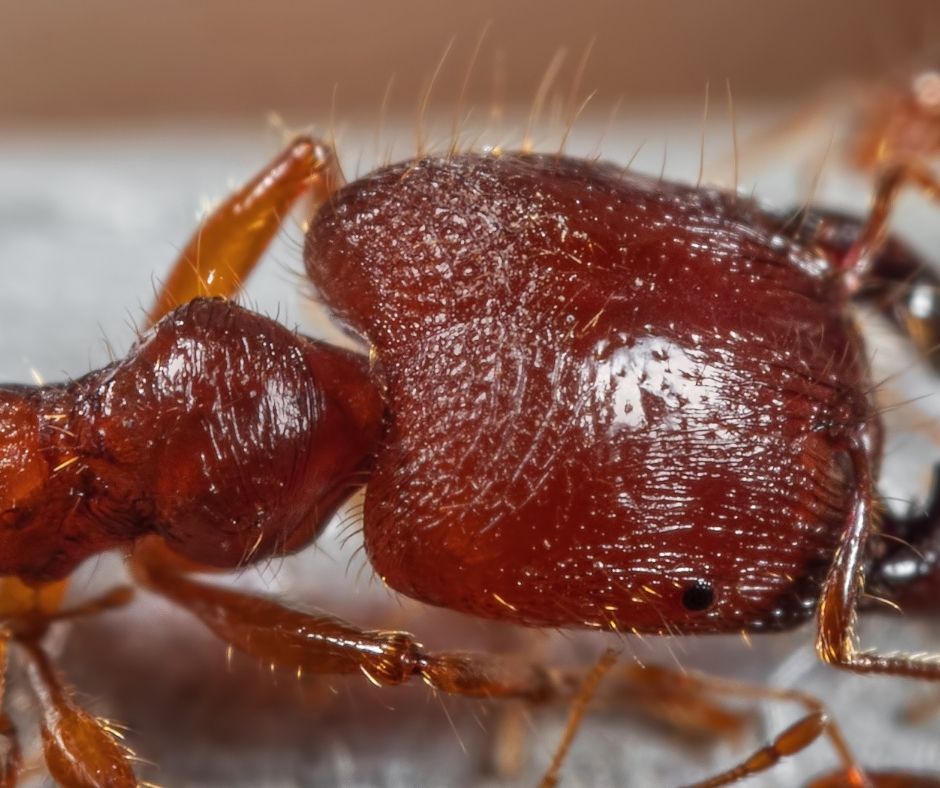The bigheaded ant thrives in heat and humidity, making them a prevalent problem during summer in Virginia. This pesky invasive species is known for displacing native ants with their supercolonies and rapid reproduction rates.
Massive numbers of bigheaded ants may be spotted indoors or surrounding the home. And they are one of the trickiest pests to control. But there’s no need to fret when you have an experienced team of pest experts at James River Pest Solutions.
Soon, you’ll know just how to identify the pest by its appearance and behavior. And we’ve also provided prevention measures, so you can do your part in keeping the bigheaded ants from infesting your home.
Appearance
A bigheaded ant colony can be identified by its dimorphic workers. In other words, there are two types of workers, major and minor. The bigheaded ant’s name comes from its major worker, which has a relatively large head compared to the rest of its body. The minor worker is much smaller. And finally, the swarmers or reproductive ants have wings with an iridescent shine.
You can use the following characteristics to help identify this ant species:
- Major workers- about 3.5 mm, dark reddish-brown color
- Minor workers- about 2 mm, light reddish-brown color
- Bodies are covered in tiny, sparse hairs
- Six legs
- Antennae
Entomologists at the University of Florida note that the bigheaded ant (BHA) is often misidentified as the Red Imported Fire ant (RIFA):
“The RIFA is sometimes confused with the BHA, but the RIFA has polymorphic (many sized) workers and the BHA is dimorphic. When disturbed, the RIFA is highly aggressive and will bite and sting, while the BHA bites but does not sting. The BHA is slightly smaller, darker colored, and less shiny than RIFA. Both nest in the soil.”

Behavior
Bigheaded ants are some of the world’s most invasive species, known to displace other native ant colonies. And because they reproduce all year long, they are tough to control. In fact, in most states, they rank with the top five ant infestations homeowners will report.
Their colonies can grow massive and include multiple nests and several queens. This is called a supercolony. And they certainly aren’t afraid to nest someplace you and your family frequently visit, like the driveway and lawn.
The bigheaded ant is not considered dangerous. They are more of a nuisance to homeowners when they find them on their property or inside the home. They won’t bite unless they are disturbed. However, the bite of this ant species is not painful.
Diet
The bigheaded ant’s omnivorous diet consists of the following:
- Honeydews
- Dead insects
- Insects smaller than them
- Soil invertebrates
Habitat
Bigheaded ants are soil-nesting ants, meaning they create those iconic piles of sand or dirt you may see in your backyard, driveway, or near the perimeter of your home. They also build mud tubes which may cause homeowners to confuse the ants with subterranean termites. These tunnels can be located along the house’s exterior or up the side of nearby trees or other structures on your property.
However, unlike termites, they are not causing any damage to the home’s structure. The bigheaded ant’s tunnels are more of an annoyance or eyesore than anything else.
Aside from right around your home, they may nest in many locations, like:
- Leaf litter
- Firewood
- Walls
- Fences
- Flower beds
- Under foundation
- Potted plants

Do You Have a Bigheaded Ant Infestation?
Infestations typically source from outside and make their way indoors in a couple of ways. When firewood or similar outdoor items are brought inside, there’s always a chance that you can move insects inside.
Bigheaded ants are notorious for entering the home by nesting inside something like a potted plant. And if food is abundant, they will rapidly reproduce and infest the house in no time.
The other way bigheaded ants make their way into your home is through tiny gaps and openings in the structure. For instance, a bigheaded ant colony nesting near the home’s exterior continues to expand and will eventually find indoor nesting spots. That is, as long as there is a tiny gap where they can enter.
Keep an eye out for the following identifiers of a bigheaded ant infestation:
- Several sand pile nests often located on pavement, like sidewalks, driveways, or brick patios
- Mud tubes along the exterior walls of the house or on other outdoor structures, like light poles or trees
- Observing dead ants or flying ants inside the home
- Ants inside the pantry or kitchen area, where food sources are abundant and accessible
Preventing Bigheaded Ants
To best control these invasive ants, start with prevention measures.
- Seal all food containers indoors and outside, including pet food and pantry food.
- Clean up after spills immediately.
- Repair all cracks, damages, and tiny openings in the structure of your home.
It’s critical to note that following these guidelines may still result in a bigheaded ant infestation. Because they are invasive and reproduce rapidly, give your local pest professionals a call as soon as possible upon spotting any bigheaded ant activity.
Get Rid of Bigheaded Ants with James River
If you’ve spotted this unique ant species in your Virginia home or on your property, call the trusted team at James River Pest Solutions. Though bigheaded ants are a challenge to control, they are no match for our experienced team.
Reach out to James River today to eliminate your bigheaded ant infestation and be on your way to a pest-free home.
